Solana and Ethereum are reshaping digital infrastructure in the blockchain world. Solana’s network can process over 65,000 transactions per second, showcasing its incredible scalability1. Smart contracts have become crucial for decentralized applications, making this tech showdown vital.
The crypto market reveals intriguing details about these blockchain networks. Solana trades at about $255, with resistance at $270 and support at $2272. Ethereum, another major player, sits around $3,3002.
We’ll explore Solana vs Ethereum’s unique strengths and innovations. We’ll examine their potential to transform digital transactions. From speed to smart contracts, we’ll highlight what makes these networks stand out.
Key Takeaways
- Solana offers unprecedented transaction speeds without complex scaling solutions
- Ethereum remains a leader in smart contract development
- Blockchain scalability is a critical factor in network performance
- Both networks continue to evolve rapidly
- Investment potential varies based on technological advancements
Overview of Solana and Ethereum
Solana and Ethereum are key players in the blockchain world. These platforms offer unique approaches to decentralized apps and network solutions. Each has its own strengths in the evolving blockchain landscape3.
Introduction to Solana
Solana is a high-performance blockchain network tackling speed and throughput challenges. It has quickly become a major player in the cryptocurrency ecosystem4.
- Founded in 2017 by Anatoly Yakovenko
- Focuses on high-speed, low-cost transactions
- Utilizes innovative Proof of History consensus mechanism
Solana’s price has reached $261. Experts predict it could rise to $500 by 20253.
Introduction to Ethereum
Ethereum pioneered smart contracts, changing blockchain tech since 2015. Known for its robust ecosystem, it’s the main platform for many decentralized apps.
Key Differences Between Solana and Ethereum
| Feature | Solana | Ethereum |
|---|---|---|
| Consensus Mechanism | Proof of History | Proof of Stake |
| Transaction Speed | 65,000 TPS | 15-30 TPS |
| Energy Efficiency | High | Improved after merge |
Solana’s active blockchain addresses are 26 times higher than Ethereum’s5. This shows Solana’s growing ecosystem and increasing adoption of decentralized apps.
Blockchain technology is not just about cryptocurrencies, but about creating more transparent and efficient systems.” – Blockchain Expert
Both networks keep pushing blockchain tech forward. They offer unique solutions for developers, investors, and users. These platforms are driving innovation in decentralized technology.
Blockchain Technology Explained
Blockchain networks are reshaping digital infrastructure with innovative consensus mechanisms. These systems use complex decentralized technologies to create scalable solutions. Understanding their technical foundations reveals a world of cutting-edge advancements.
Solana’s Proof of History: A Unique Consensus Approach
Solana’s Proof of History (PoH) is a groundbreaking proof-of-stake consensus mechanism. It creates a historical record proving when events occurred. This approach allows for thousands of transactions per second.
- Creates cryptographic timestamps
- Enables rapid transaction verification
- Enhances blockchain scalability
Ethereum’s Evolution to Proof of Stake
Ethereum switched from proof-of-work to proof-of-stake, cutting energy use dramatically. This change tackles blockchain scalability issues. It uses a more sustainable process to validate transactions.
Consensus mechanisms are the heartbeat of blockchain technology, determining how transactions are verified and recorded.
Scalability Solutions in Blockchain Networks
Cross-chain interoperability is now crucial for Solana and Ethereum. Both networks are developing unique strategies. They aim to boost transaction speeds and lower costs6.
| Network | Transactions per Second | Transaction Cost |
|---|---|---|
| Solana | Thousands | Cents |
| Ethereum | 15-30 | Variable |
Blockchain technologies continue to evolve at a rapid pace. They show great promise in transforming how we interact digitally. The future of decentralized systems looks bright and full of potential7.
Performance Comparison
Solana and Ethereum’s capabilities differ greatly in blockchain performance. Network throughput and transaction fees are key areas where these platforms compete. Let’s explore their strengths and weaknesses.
Transaction Speed Metrics
Blockchain scalability sets these networks apart dramatically. Solana processes thousands of transactions per second with its Proof-of-History mechanism8. Ethereum, meanwhile, has been upgrading to improve its transaction speeds.
- Solana: Approximately 300 million monthly votes7
- Average block time: Just 2 seconds7
- Potential daily transaction processing: 43,200 transactions7
Cost of Transactions
Transaction fees are another crucial performance indicator. Solana offers much lower costs than Ethereum. This makes Solana attractive for developers and users seeking cost-effective blockchain solutions.
The future of blockchain lies in balancing speed, cost, and reliability.” – Blockchain Expert
Network Throughput Statistics
Network throughput shows blockchain efficiency clearly. Solana’s infrastructure allows rapid processing of stablecoin transactions. Circle minted $3.5 billion USDC on Solana in just one week9.
This proves Solana’s ability to handle high-volume financial operations. It demonstrates the platform’s robust capacity for large-scale transactions.
| Metric | Solana | Ethereum |
|---|---|---|
| Transactions per Second | Thousands | Fewer than 15 |
| Average Transaction Cost | Fraction of a cent | $5-$50 |
Our comparison shows both networks have strengths. However, Solana currently leads in transaction speed and cost-effectiveness. Developers and investors should weigh these factors carefully.
Consider these metrics when choosing a blockchain platform7. They can greatly impact your project’s success and efficiency.
PlutoChain Performance Data8Blockchain Network Capabilities9Circle USDC Minting Report
Use Cases and Applications
Blockchain tech has changed digital interactions through dApps and new platforms. Digital finance keeps evolving with networks like Solana and Ethereum. These networks are exploring new blockchain frontiers.
DeFi Innovations on Ethereum
Ethereum leads in decentralized finance (DeFi). It hosts many smart contracts for complex financial operations. The network supports various financial apps.
- Lending platforms
- Decentralized exchanges
- Yield farming protocols
Blockchain investment is growing fast. In one week, 20 global events raised over $98 million10. Six of these events focused on DeFi innovations10.
NFT Marketplaces on Solana
Solana shines as a platform for NFT marketplaces. It offers cross-chain interoperability and fast transactions. Recent developments show Solana’s growing ecosystem:
| Project | Funding | Ecosystem |
|---|---|---|
| Ranger Protocol | $1.9 million | Crypto Derivatives Exchange |
| Wingbits | $5.6 million | DePIN Startup |
Enterprise Blockchain Implementations
Ethereum and Solana are catching enterprise attention. Hybrid crypto exchanges like GRVT show promise for institutional blockchain use. GRVT averages $50 million in daily trading with 55 institutional clients10.
“The future of finance lies in decentralized technologies that offer speed, security, and accessibility.” – Blockchain Innovation Expert
Community and Ecosystem
Blockchain networks thrive on vibrant developer ecosystems and engaged communities. Solana and Ethereum have unique approaches to building their technological communities6.
Developer Engagement and Support
Solana has attracted over 7,600 new developers recently. This shows significant growth in technical talent6.
The network offers tools for creating dApps with low costs and high-speed processing. These features make it attractive to developers6.
- Low-cost transaction environment
- High-performance blockchain infrastructure
- Comprehensive developer resources
Partnerships and Collaborations
Cross-chain interoperability is now crucial for blockchain networks. Strategic partnerships help expand capabilities and market reach11.
Projects like PlutoChain show potential for seamless blockchain interactions. They offer Ethereum compatibility, bridging different blockchain ecosystems6.
| Network | Key Collaboration Strengths |
|---|---|
| Solana | Rapid transaction processing |
| Ethereum | Extensive smart contract capabilities |
Community Initiatives and Governance
Blockchain governance is crucial for network development. Community-driven decision-making processes shape network upgrades and improvements12.
The future of blockchain is collaborative and transparent.
Institutional interest validates these blockchain networks. Ongoing developments suggest significant potential for growth and innovation6.
Investment Potential
Cryptocurrency investments are captivating investors worldwide. Blockchain scalability is now crucial in assessing network potential. The digital asset market offers unique opportunities for those who grasp its complex dynamics.
Current Market Trends
The blockchain ecosystem is evolving rapidly. Network throughput and cross-chain interoperability are advancing quickly. Recent market data reveals intriguing investment insights:
- Solana demonstrated a significant price surge of 40.00% over the past month4
- Cryptocurrency markets show volatility with potential high-growth opportunities
- Emerging blockchain technologies continue to attract significant investor attention
Price Predictions for 2024
Investors are watching blockchain networks closely. The current crypto landscape suggests exciting possibilities:
| Cryptocurrency | Current Price | Potential Growth |
|---|---|---|
| Solana | $255 | 40% Monthly Growth4 |
| Ethereum | $3,300 | Moderate Potential |
Long-term Viability Assessment
Network performance and technological innovation will be critical factors in determining long-term blockchain investment potential. Investors should consider:
- Blockchain scalability capabilities
- Cross-chain interoperability features
- Network throughput performance
- Developer ecosystem strength
The future of blockchain investments lies in understanding technological fundamentals beyond mere price speculation.
Blockchain networks are more than digital assets. They’re transformative tech platforms with significant economic impact11. Smart investors recognize this potential.
Tools for Developers
Blockchain development demands understanding the right tools and environments. Solana and Ethereum offer unique developer ecosystems for smart contracts and dApps. These platforms can revolutionize your blockchain journey with innovative technologies.
Development Environments and Frameworks
Blockchain developers have powerful options for creating cutting-edge applications. Key platforms include:
- Solana CLI – Rust-based development toolkit
- Hardhat – Ethereum smart contract development environment
- Anchor – Solana’s comprehensive framework
- Truffle Suite – Ethereum blockchain development platform
Programming Languages
Blockchain networks support unique programming languages for smart contracts and dApps:
| Blockchain | Primary Languages | Secondary Languages |
|---|---|---|
| Solana | Rust | C, C++ |
| Ethereum | Solidity | Python, JavaScript |
Available APIs and SDKs
Robust APIs and SDKs simplify blockchain development. Over 7,600 new developers have joined the Solana ecosystem6. This shows growing interest in blockchain technologies.
Key development resources include Web3.js, Solana.js, and Ethers.js13.
“The right development tools can transform complex blockchain concepts into practical, scalable solutions.”
Mastering these tools is crucial for developers exploring blockchain’s potential. They enable the creation of innovative decentralized applications.
These tools help push technological boundaries in the blockchain space. Developers can create solutions that revolutionize various industries.
Security and Risks
Blockchain security is crucial for cryptocurrency platforms. It requires robust mechanisms beyond traditional cybersecurity. Blockchain networks like Solana and Ethereum constantly improve their security to counter new threats.
Solana’s Security Architecture
Solana uses advanced security in its proof-of-stake consensus. The network has created innovative strategies to reduce potential weaknesses6.
Key security elements include:
- Multi-layer authentication protocols
- Rapid transaction verification systems
- Enhanced smart contracts validation
Ethereum’s Security Approach
Ethereum’s security focuses on protection through cross-chain strategies. The network prioritizes:
- Decentralized security mechanisms
- Advanced cryptographic techniques
- Community-driven vulnerability assessments
Recent Security Incidents Analysis
Blockchain networks face ongoing security challenges. Solana has shown resilience by implementing robust architectural defenses14.
Recent upgrades introduce advanced techniques like zkSNARKs and zkSTARKs. These enhance overall protection14.
In the world of blockchain, security isn’t just a feature – it’s the foundation of trust.” – Blockchain Security Expert
Investors and developers must understand potential risks in the complex world of cryptocurrency platforms.
| Network | Security Feature | Vulnerability Mitigation |
|---|---|---|
| Solana | Proof of History | High-speed transaction verification |
| Ethereum | Proof of Stake | Decentralized consensus mechanism |
FAQs about Solana vs Ethereum
Blockchain networks can be complex. Understanding Solana and Ethereum is key for making smart choices in crypto. Let’s explore their differences and strengths.
What are the Main Advantages of Solana?
Solana shines with its amazing blockchain scalability. It can handle thousands of transactions per second, making it super efficient15.
Solana’s key perks include:
- Lightning-fast transaction speeds
- Significantly lower transaction fees
- Advanced network upgrades improving scalability15
Is Ethereum Still a Better Investment?
Ethereum remains a crypto giant. Recent trends show strong potential, with big institutions showing interest. Experts predict Ethereum could hit $12,000 by late 202516.
“The blockchain landscape is dynamic, and both networks offer unique value propositions.”
How to Choose Between Solana and Ethereum?
Picking the right blockchain depends on your needs. Think about these factors:
- Project requirements
- Energy efficiency considerations
- Transaction fee structures
- Ecosystem support
Solana’s stablecoin market cap is impressive at $10.7 billion17. It handles about 350 million transactions daily17, showing its strong performance.
Pro tip: Always evaluate your specific use case when choosing between these blockchain networks.
Conclusion: The Future of Blockchain Networks
Solana and Ethereum are driving blockchain innovation. They’re reshaping digital infrastructure and decentralized technologies. The crypto market’s volatility highlights the need to understand these platforms18.
Developer ecosystems are crucial in transforming blockchain networks. Emerging crypto trends show that innovation is key to growth19. Ethereum’s move to Proof-of-Stake points to efficient, eco-friendly blockchain solutions19.
The opportunity for investors and developers is clear. Stay informed and adaptable in the blockchain world. The future favors those who can use Solana and Ethereum’s strengths18.
The Road Ahead
Blockchain tech will keep advancing in scalability and security. Solana and Ethereum’s rivalry will spark innovation. This creates exciting chances for blockchain explorers19.

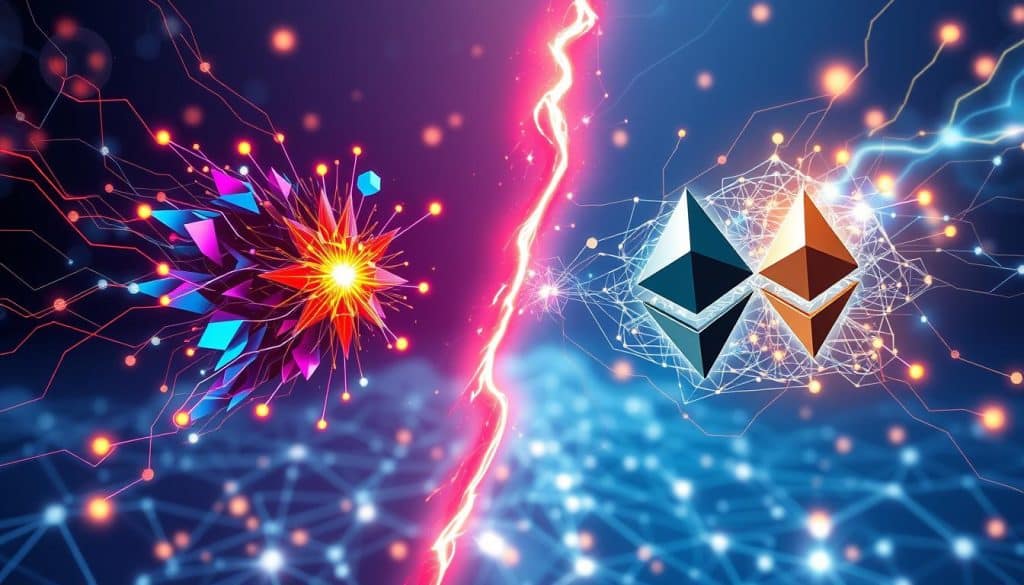

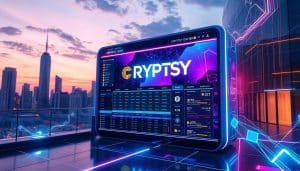








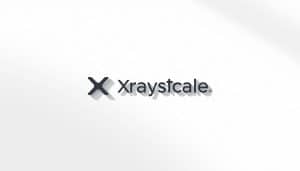




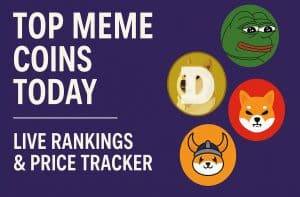




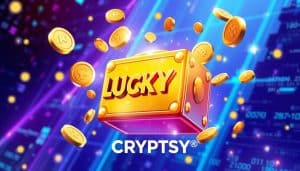

 Bitcoin
Bitcoin  Ethereum
Ethereum  Tether
Tether  XRP
XRP  USDC
USDC  Lido Staked Ether
Lido Staked Ether  TRON
TRON  Dogecoin
Dogecoin  Cardano
Cardano  Figure Heloc
Figure Heloc  WhiteBIT Coin
WhiteBIT Coin  Wrapped stETH
Wrapped stETH  Bitcoin Cash
Bitcoin Cash  Wrapped Bitcoin
Wrapped Bitcoin  USDS
USDS  Chainlink
Chainlink  Wrapped eETH
Wrapped eETH  Binance Bridged USDT (BNB Smart Chain)
Binance Bridged USDT (BNB Smart Chain)  LEO Token
LEO Token  WETH
WETH  Hyperliquid
Hyperliquid  Monero
Monero  Stellar
Stellar  Zcash
Zcash  Ethena USDe
Ethena USDe  Coinbase Wrapped BTC
Coinbase Wrapped BTC  Litecoin
Litecoin  Sui
Sui  Avalanche
Avalanche  Hedera
Hedera  Shiba Inu
Shiba Inu  sUSDS
sUSDS  USDT0
USDT0  Dai
Dai  Mantle
Mantle  PayPal USD
PayPal USD  Toncoin
Toncoin  World Liberty Financial
World Liberty Financial  Cronos
Cronos  Ethena Staked USDe
Ethena Staked USDe  Uniswap
Uniswap  Polkadot
Polkadot  MemeCore
MemeCore  Aave
Aave  USD1
USD1  Bittensor
Bittensor  Rain
Rain  Canton
Canton